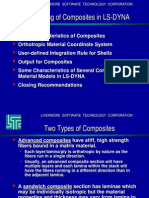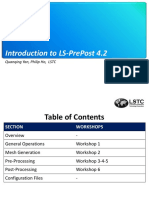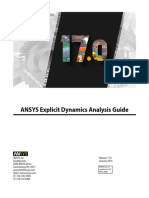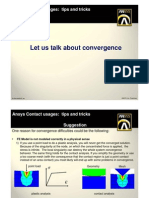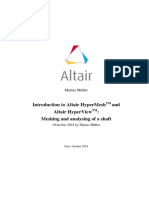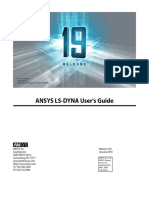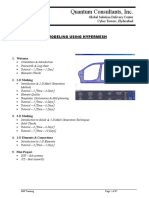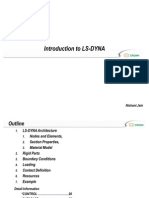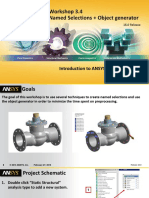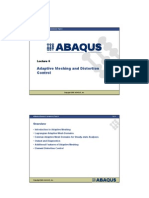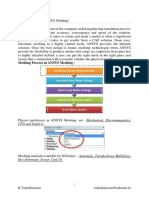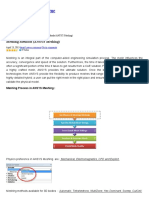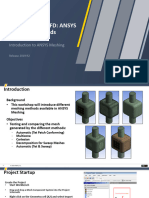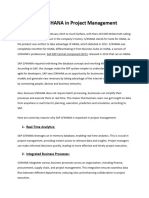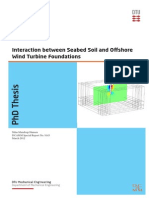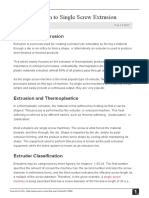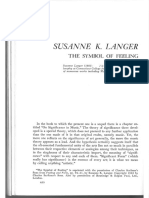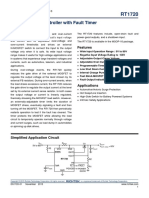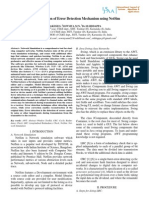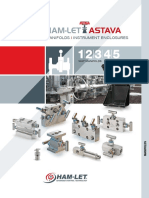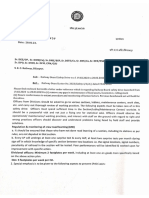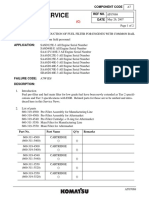Chapter 6 Explicit Dynamics: Meshing
ANSYS Explicit Dynamics
ANSYS, Inc. Proprietary 2009 ANSYS, Inc. All rights reserved.
6-1
February 27, 2009 Inventory #002665
�Explicit Dynamics: Meshing
What is required of Meshes for Explicit Applications?
Uniform element size (in finest zoned regions)
Smallest element size controls the time step used to advance the solution in time Explicit analyses compute dynamic stress waves that propagate throughout the entire mesh
Training Manual
Element size controlled by the user throughout the mesh
Not automatically dependent on geometry
Implicit analyses usually have static region of stress concentration where mesh is refined (strongly dependent on geometry) In explicit analyses, the location of regions of high stress constantly change as stress waves propagate through the mesh
Mesh refinement is usually used to improve efficiency
Mesh transitions should be smooth for maximum accuracy
Hex-dominant meshing preferred
More efficient Sometimes more accurate for slower transients
ANSYS, Inc. Proprietary 2009 ANSYS, Inc. All rights reserved.
6-2
February 27, 2009 Inventory #002665
�Explicit Dynamics: Meshing
Mesh
Right-click Mesh in the Outline Tree to: Insert Method Important for Explicit Sizing Contact Sizing Refinement Mapped Face Meshing Match Control Pinch Inflation Update Generate Mesh Preview Surface Mesh Show Sweepable Bodies Preview Inflation Clean Rename
Training Manual
ANSYS, Inc. Proprietary 2009 ANSYS, Inc. All rights reserved.
6-3
February 27, 2009 Inventory #002665
�Explicit Dynamics: Meshing
Meshing Methods Solid Bodies
Automatic Tetrahedron Hex Dominant Sweep Multizone CFX-Mesh
Training Manual
Surface Bodies (Shells)
Quadrilateral Dominant Triangles Uniform Quad / Tri Uniform Quad
Line Bodies (Beams)
Automatic
ANSYS, Inc. Proprietary 2009 ANSYS, Inc. All rights reserved.
6-4
February 27, 2009 Inventory #002665
�Explicit Dynamics: Meshing
Meshing Methods Solid Bodies
Training Manual
Tetrahedrons
Advantages
An arbitrary volume can always be filled with tetrahedra Can be generated quickly, automatically, and for complicated geometry
Disadvantages
Element and node counts are higher than for a hex mesh with a similar mesh density Generally not possible to align the cells with a flow direction Not well suited for thin solids or annuli due to non-isotropy of geometry and nature of element
6-5
February 27, 2009 Inventory #002665
ANSYS, Inc. Proprietary 2009 ANSYS, Inc. All rights reserved.
�Explicit Dynamics: Meshing
Meshing Methods Solid Bodies Tetrahedrons - Patch Conforming
Default Tetrahedron Mesher All Faces, Edges, Vertices of the geometry are respected during mesh generation Delaunay Method Not good for Explicit Dynamics
Training Manual
Curves in Geometry are Reflected in the Mesh
ANSYS, Inc. Proprietary 2009 ANSYS, Inc. All rights reserved.
6-6
February 27, 2009 Inventory #002665
�Explicit Dynamics: Meshing
Meshing Methods Solid Bodies Tetrahedrons - Patch Independent
Recommended Tet mesher for Explicit Faces, Edges, Vertices not always respected Octree Method Element size Defined By
Maximum Element Size Approx. number of Elements
Training Manual
Max. Element Size = 2.5 mm
Max. Element Size = 1.0 mm
Curves in Geometry NOT reflected in the Mesh
ANSYS, Inc. Proprietary 2009 ANSYS, Inc. All rights reserved.
6-7
February 27, 2009 Inventory #002665
�Explicit Dynamics: Meshing
Meshing Solid Bodies Hex Dominant
Useful for meshing bodies that cannot be swept Recommended for meshing bodies with large interior volumes The hex-dominant meshing algorithm creates a quaddominant surface mesh first, then pyramid and tetrahedral elements are filled in as needed
Always check interior of mesh for good element structure Control Messages will appear to warn you if volume may not be suitable for hex-dominant meshing
Training Manual
Solid Model with Hex dominant mesh : Tetrahedrons 443 (9%) Hexahedron 2801(62%) Wedge 124 (2%) Pyramid 1107 (24%)
ANSYS, Inc. Proprietary 2009 ANSYS, Inc. All rights reserved. February 27, 2009 Inventory #002665
6-8
�Explicit Dynamics: Meshing
Meshing Methods Solid Bodies
Training Manual
Hex Dominant
Sometimes produces a better (more uniform) mesh if a size control is placed on one or more edges / surfaces of a body
ANSYS, Inc. Proprietary 2009 ANSYS, Inc. All rights reserved.
6-9
February 27, 2009 Inventory #002665
�Explicit Dynamics: Meshing
Mesh Methods - Sweeping Sweep methods for generating pure hex meshes
Sweep
Sweeping from a single source face to a single target face
Training Manual
Thin Sweep
Good at handling multiple sources and targets for thin parts
Multizone
Uses a free decomposition approach Attempts to automatically slice geometry into sweepable regions Supports multi-source and multi-target
ANSYS, Inc. Proprietary 2009 ANSYS, Inc. All rights reserved.
6-10
February 27, 2009 Inventory #002665
�Explicit Dynamics: Meshing
Meshing Methods Sweeping Multizone
Training Manual
Direct decomposition of complex geometries at the time of meshing to create a hex mesh
Select source and target surfaces for the Multizone sweep mesher
ANSYS, Inc. Proprietary 2009 ANSYS, Inc. All rights reserved.
6-11
February 27, 2009 Inventory #002665
�Explicit Dynamics: Meshing
Sweep vs. Thin Sweep
Use Sweep When:
Sweep
Training Manual
The side faces are not thin You only have 1 source and 1 target The sweep direction changes along the path Use Thin Sweep When: The side faces are thin
In general, thin means that the side faces are small in relation to the source faces (aspect ratio of sides/sources is ~ 1/5th)
You only have multiple sources and targets Path is linear
ANSYS, Inc. Proprietary 2009 ANSYS, Inc. All rights reserved.
Thin Sweep
6-12
February 27, 2009 Inventory #002665
�Explicit Dynamics: Meshing
Sweep vs. MultiZone
Preview Sweepable Bodies shows all bodies that are sweepable
Training Manual
Use Sweep when you have a multibody part where some bodies should be meshed with Sweep, and some with Patch Conforming Tet
Use MultiZone when
you are meshing single body parts that are too complicated for Sweep you have multiple sources and targets you need to respect
Example:
Using Sweep, the single body part (left) must be manually sliced into a Multibody part containing five bodies (center) to obtain a pure hex mesh (right) With Multizone, it is meshed automatically!
ANSYS, Inc. Proprietary 2009 ANSYS, Inc. All rights reserved.
6-13
February 27, 2009 Inventory #002665
�Explicit Dynamics: Meshing
Thin Sweep vs. MultiZone
Training Manual
Use Thin Sweep when you have a thin solid part where the source and target faces dont exactly match, and you dont care about the features on the target side
Multiple source
Multiple target
Multiple sources captured
Multiple targets ignored
ANSYS, Inc. Proprietary 2009 ANSYS, Inc. All rights reserved.
6-14
February 27, 2009 Inventory #002665
�Explicit Dynamics: Meshing
Thin Sweep vs. MultiZone
Training Manual
Use MultiZone when you have a thin solid part where the source and target faces dont exactly match, and you care about the features on both sides
Multiple source
Multiple target
Multiple sources captured
Multiple targets captured
ANSYS, Inc. Proprietary 2009 ANSYS, Inc. All rights reserved.
6-15
February 27, 2009 Inventory #002665
�Explicit Dynamics: Meshing
Meshing Methods - Solid Bodies
Training Manual
Automatic (Patch Conforming/Sweeping)
Sweepable bodies are automatically swept If a solid body cannot be swept it will be meshed using the Patch Conforming Tetrahedron mesher
This is the default Method for Explicit Ensures that preferred Hex meshes are generated whenever bodies can be swept If any bodies are not swept, the tetrahedron meshes generated for these bodies should be remeshed by inserting a method that generates a Patch Independent Tet. mesh for those bodies
6-16
February 27, 2009 Inventory #002665
ANSYS, Inc. Proprietary 2009 ANSYS, Inc. All rights reserved.
�Explicit Dynamics: Meshing
Meshing Methods Surface Bodies (Shells)
Training Manual
Quad Dominant
Triangles
(not recommended for explicit)
Uniform Quad / Tri
Use sizing controls to obtain uniform element size
ANSYS, Inc. Proprietary 2009 ANSYS, Inc. All rights reserved.
6-17
February 27, 2009 Inventory #002665
�Explicit Dynamics: Meshing
Meshing Line Bodies (Beams)
Method is Automatic Cross-section is assigned Can be visualized as line segments or showing cross-section Use sizing controls to obtain uniform element size
Training Manual
ANSYS, Inc. Proprietary 2009 ANSYS, Inc. All rights reserved.
6-18
February 27, 2009 Inventory #002665
�Explicit Dynamics: Meshing
Mesh Sizing Sizing can be applied to
Body Face Edge Vertex
Training Manual
Three options
Element Size (Body, Face, Edge) Number of Divisions (Edge) Sphere of Influence (Body, Face, Edge, Vertex)
ANSYS, Inc. Proprietary 2009 ANSYS, Inc. All rights reserved.
6-19
February 27, 2009 Inventory #002665
�Explicit Dynamics: Meshing
Mesh Sizing
Element Size
Element Size specifies average element edge length for bodies, faces or edges
Often will also improves mesh quality
Training Manual
ANSYS, Inc. Proprietary 2009 ANSYS, Inc. All rights reserved.
6-20
February 27, 2009 Inventory #002665
�Explicit Dynamics: Meshing
Mesh Sizing
Number of Divisions
Specifies number of elements on edge(s) of bodies or faces Bias Type
Edge is discretized to include a bias towards one end, both ends, or the center Bias Factor is ratio of largest element size to smallest element size Effect of the Bias Factor is displayed
Training Manual
ANSYS, Inc. Proprietary 2009 ANSYS, Inc. All rights reserved.
6-21
February 27, 2009 Inventory #002665
�Explicit Dynamics: Meshing
Mesh Sizing
Number of Divisions
Behavior
Soft (default) Size control and Number of Divisions used is controlled by the meshing algorithm Affected by proximity, curvature and local re-meshing during the meshing process Hard Specified Number of Divisions is fixed and cannot be changed by the meshing algorithm Increases likelihood of mesh generation failure Can have positive or negative effects on mesh quality No Edge Sizing Soft Hard
Training Manual
ANSYS, Inc. Proprietary 2009 ANSYS, Inc. All rights reserved.
6-22
February 27, 2009 Inventory #002665
�Explicit Dynamics: Meshing
Mesh Sizing
Sphere of Influence
Elements associated with the scoped entities, that are within the Sphere Radius have the specified Element Size
Vertex Sizing
Training Manual
Body Sizing
Vertex is the center of the sphere Vertex sizing is applied to all entities
ANSYS, Inc. Proprietary 2009 ANSYS, Inc. All rights reserved.
For any entity other than a vertex, the definition of a Sphere of Influence requires that a Coordinate System be defined to set the center of the Sphere
6-23
February 27, 2009 Inventory #002665
�Explicit Dynamics: Meshing
Mesh Sizing
Sphere of Influence
Elements associated with the scoped entities, that are within the Sphere Radius have the specified Element Size
Scoped to 1 Face Scoped to 2 Faces
Training Manual
Scoped to 3 Faces
Scoped to 1 Body
Surface meshing identical
Interior meshing different
ANSYS, Inc. Proprietary 2009 ANSYS, Inc. All rights reserved.
6-24
February 27, 2009 Inventory #002665
�Explicit Dynamics: Meshing
Defeaturing
Training Manual
Defeaturing reduces the influence that geometric features have on the meshing process
Avoids generating small elements that may force explicit calculations to run with a small time step
Two Meshing options are available for Defeaturing
Virtual topology Defeaturing tolerance
Can only be used with for Patch Independent Tetrahedral meshes
ANSYS, Inc. Proprietary 2009 ANSYS, Inc. All rights reserved.
6-25
February 27, 2009 Inventory #002665
�Explicit Dynamics: Meshing
Defeaturing
Training Manual
Virtual Topology
Default Mesh Small feature controls smallest element size and mesh type
Create a virtual face from small feature and larger body
Mesh is now uniform Hex Feature is simply meshed over Element size significantly improved
6-26
February 27, 2009 Inventory #002665
ANSYS, Inc. Proprietary 2009 ANSYS, Inc. All rights reserved.
�Explicit Dynamics: Meshing
Defeaturing
Training Manual
Virtual Topology & CAD
Virtual Cell
ANSYS, Inc. Proprietary 2009 ANSYS, Inc. All rights reserved.
6-27
February 27, 2009 Inventory #002665
�Explicit Dynamics: Meshing
Defeaturing
Training Manual
Defeaturing Tolerance
Only for Patch Independent Tetrahedrons
Without Defeaturing Tolerance
With Defeaturing Tolerance mesh ignores small feature Much better element size
ANSYS, Inc. Proprietary 2009 ANSYS, Inc. All rights reserved.
6-28
February 27, 2009 Inventory #002665
�Explicit Dynamics: Meshing
DM (DesignModeler) and Meshing
Bodies and Parts
Design-Modeler contains three different body types: Solid body: Body has surface area and volume Surface body: Body has surface area but no volume Line body: Body consists entirely of edges, no area, no volume By default, DM places each body into one part by itself Individual parts will always be meshed separately
If bodies in separate parts share faces, the meshes on those shared faces will not be matched
Training Manual
Multiple bodies in a single part will have matched meshes on shared faces
ANSYS, Inc. Proprietary 2009 ANSYS, Inc. All rights reserved.
6-29
February 27, 2009 Inventory #002665
�Explicit Dynamics: Meshing
DM and Meshing Bodies and Parts
Example: In DM: 1 part, 1 body consisting of 1 solid During Meshing: 1 solid ,1body Entire solid meshed as one entity No internal surfaces
Mesh DM
Training Manual
ANSYS, Inc. Proprietary 2009 ANSYS, Inc. All rights reserved.
6-30
February 27, 2009 Inventory #002665
�Explicit Dynamics: Meshing
DM and Meshing Bodies and Parts
Example: In DM: 3 parts, 3 bodies consisting of 3 solids During Meshing: 3 solids, 3 bodies Each solid meshed independently
Nodes are not shared Nodes do not line-up Mesh DM
Training Manual
ANSYS, Inc. Proprietary 2009 ANSYS, Inc. All rights reserved.
6-31
February 27, 2009 Inventory #002665
�Explicit Dynamics: Meshing
DM and Meshing Bodies and Parts
Example: In DM: 1 multi-body part, 3 bodies / solids During Meshing:1 multi-body part, 3 bodies / solids Each solid meshed independently but node connectivity among solids is preserved Mesh DM
Training Manual
ANSYS, Inc. Proprietary 2009 ANSYS, Inc. All rights reserved.
6-32
February 27, 2009 Inventory #002665
�Explicit Dynamics: Meshing
DM and Meshing - Slice
Training Manual
Slice geometry in Design Modeler to generate a Swept Hex Mesh
Original Geometry
Default Mesh
Sliced Geometry
ANSYS, Inc. Proprietary 2009 ANSYS, Inc. All rights reserved.
Default Mesh
6-33
February 27, 2009 Inventory #002665
�Explicit Dynamics: Meshing
DM and Meshing Slice
Training Manual
Combine Sliced Bodies into single Part to get Mesh to Match across body boundaries
Single Body Parts
Multi-body Part
ANSYS, Inc. Proprietary 2009 ANSYS, Inc. All rights reserved.
6-34
February 27, 2009 Inventory #002665
�Explicit Dynamics: Meshing
DM and Meshing Shared Topology & Match Mesh Overlapping Meshes and Contact
Explicit Dynamic Analyses require that there are no initial penetrations at contact surfaces For arbitrarily shaped bodies, this requires that nodes on surfaces that are initially in contact must match Shared Topology and Match Mesh Where Possible options allow you to do this
Training Manual
ANSYS, Inc. Proprietary 2009 ANSYS, Inc. All rights reserved.
6-35
February 27, 2009 Inventory #002665
�Explicit Dynamics: Meshing
DM and Meshing - Shared Topology and Match Mesh
Specified for each Part (in DM)
Applied at common boundaries of all Bodies in the Part
Training Manual
Options
Automatic (default)
Nodes are merged (bodies are bonded)
None
Bodies are meshed independently
Imprint
Meshes are across interfaces of bodies contained in Multi-Body Parts
When used with Match Mesh Where Possible option for Patch Independent Tetrahdron meshing, can prevent unwanted initial contact penetration
New feature in 12.0. Currently only implemented for tetrahedra
ANSYS, Inc. Proprietary 2009 ANSYS, Inc. All rights reserved.
6-36
February 27, 2009 Inventory #002665
�Explicit Dynamics: Meshing
DM and Meshing - Shared Topology and Match Mesh
Training Manual
No Match Mesh
Automatic
None
Imprint
Only Automatic has matching meshes
ANSYS, Inc. Proprietary 2009 ANSYS, Inc. All rights reserved.
6-37
February 27, 2009 Inventory #002665
�Explicit Dynamics: Meshing
DM and Meshing - Shared Topology and Mesh Matching
Training Manual
Mesh matching where possible
Automatic
None
Imprint
All cases have matching meshes
ANSYS, Inc. Proprietary 2009 ANSYS, Inc. All rights reserved. February 27, 2009 Inventory #002665
6-38
�Explicit Dynamics: Meshing
DM and Meshing - Spot Welds
Define points on source geometry at location of the spot welds Corresponding points on target geometry are generated
Source geometry and target geometry can be in contact or separated
Training Manual
Meshing ensures that nodes are generated at the spot weld points
Explicit Dynamics uses nodes to define solid or breakable joints
ANSYS, Inc. Proprietary 2009 ANSYS, Inc. All rights reserved.
6-39
February 27, 2009 Inventory #002665
�Explicit Dynamics: Meshing
DM and Meshing - Mid-Surface Creation
Mid-Surface
Reduces 3D geometry of constant thickness to a simplified shell representation Automatically places surface body at mid point between 3D face pairs Allows shell element type meshing in Explicit Dynamics
Training Manual
3D Model
ANSYS, Inc. Proprietary 2009 ANSYS, Inc. All rights reserved.
Mid-Surface representation
6-40
February 27, 2009 Inventory #002665
�Explicit Dynamics: Meshing
DM and Meshing Surface Extension
Surface Extension
Creates a surface extension based on edge selection Often required after Mid-Surface operation
Training Manual
A thin solid model
The model is converted to a mid plane surface model. The result is a gap at the intersection of the 2 parts
6-41
Extending the circular edge closes the gap
February 27, 2009 Inventory #002665
ANSYS, Inc. Proprietary 2009 ANSYS, Inc. All rights reserved.
�Explicit Dynamics: Meshing
DM and Meshing Named Selections
Training Manual
Create Named Selections in DM or Meshing
Can be used to apply constraints and boundary conditions in Explicit Dynamics
ANSYS, Inc. Proprietary 2009 ANSYS, Inc. All rights reserved.
6-42
February 27, 2009 Inventory #002665
�Explicit Dynamics: Meshing
DM and Meshing - Cleanup and Repair of CAD
Edge and Face Merge for Model Simplification
Merge edges and faces based on angle criteria to simplify the model
Training Manual
ANSYS, Inc. Proprietary 2009 ANSYS, Inc. All rights reserved.
6-43
February 27, 2009 Inventory #002665
�Explicit Dynamics: Meshing
DM and Meshing - Cleanup and Repair of CAD Repair
Training Manual
ANSYS, Inc. Proprietary 2009 ANSYS, Inc. All rights reserved.
6-44
February 27, 2009 Inventory #002665
�Explicit Dynamics: Meshing
DM and Meshing - Cleanup and Repair of CAD
Patch healing
Training Manual
Face Delete
Natural healing
Selected faces for delete
ANSYS, Inc. Proprietary 2009 ANSYS, Inc. All rights reserved.
6-45
February 27, 2009 Inventory #002665
�Explicit Dynamics: Meshing
FEModeler
Training Manual
Import a finite element (FE) model from a NASTRAN bulk data file or ABAQUS Input file. Import FE information from Workbench Meshing or Advanced Meshing Import archived ANSYS data created using the CDWRITE command. Navigate and visualize the data contained in the model. Generate a geometry from an FE Model using the Geometry Synthesis feature. Create named components based on element selections. Generate an ANSYS, NASTRAN, or ABAQUS input deck for downstream analysis.
ANSYS, Inc. Proprietary 2009 ANSYS, Inc. All rights reserved.
6-46
February 27, 2009 Inventory #002665
�Explicit Dynamics: Meshing
FEModeler
Import ANSYS model file into Workbench
Training Manual
Open the imported model in FEModeler
ANSYS, Inc. Proprietary 2009 ANSYS, Inc. All rights reserved.
6-47
February 27, 2009 Inventory #002665
�Explicit Dynamics: Meshing
FEModeler
Display Element Statistics in FEModeler
Training Manual
ANSYS, Inc. Proprietary 2009 ANSYS, Inc. All rights reserved.
6-48
February 27, 2009 Inventory #002665
�Explicit Dynamics: Meshing
FEModeler
Convert to Geometry (Geometry Synthesis / Skin Detection)
Training Manual
ANSYS, Inc. Proprietary 2009 ANSYS, Inc. All rights reserved.
6-49
February 27, 2009 Inventory #002665
�Explicit Dynamics: Meshing
FEModeler
Pass Geometry to Meshing
Training Manual
ANSYS, Inc. Proprietary 2009 ANSYS, Inc. All rights reserved.
6-50
February 27, 2009 Inventory #002665
�Explicit Dynamics: Meshing
Workshop 3 Can Crush
Goal:
Crush an aluminum beverage can and allow it to springback
Training Manual
Procedure:
Create an Explicit Dynamics (ANSYS) Analysis System Project Select the units system and define the material properties Import, modify, and mesh the soda can geometry Define analysis settings, boundary conditions, and external loads Initiate the solution (AUTODYN - STR) and review the results
ANSYS, Inc. Proprietary 2009 ANSYS, Inc. All rights reserved.
6-51
February 27, 2009 Inventory #002665



